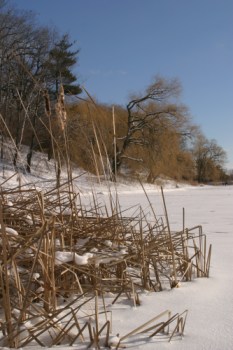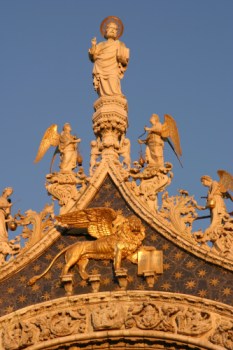Colin's Journal: A place for thoughts about politics, software, and daily life.
January 22nd, 2004
Design, fly, and print.
I intended to update the design of my web pages for the winter, but I’ve not got around to doing it. At this rate it will be spring before I do it, and then I’ll be six months out of sync with the world (or rather the bit of it that I’m in). It took a long time and a fair amount of effort to design and implement the current look, so maybe I should start now in preparation for next winter.
This week has mostly been dominated by work. I’m off to Mexico again on Sunday, this time for a week, and there has been a lot of preparation work to do. I expect a good but challenging trip, and very little if any free time.
 I spent Sunday afternoon wading through snow in High Park trying to take good pictures. I took a few nice ones, including this one of the reeds (click for larger version). By the time I got home I was thoroughly soaked and frozen, the combination of darkness and wind more than making up for warm clothing.
I spent Sunday afternoon wading through snow in High Park trying to take good pictures. I took a few nice ones, including this one of the reeds (click for larger version). By the time I got home I was thoroughly soaked and frozen, the combination of darkness and wind more than making up for warm clothing.
I would like to make large prints of some of my photos, but given the cost involved, I decided I would start with some small sizes first. My first set look OK, but the colours are rather washed out compared to the view on my screen. Of course my screen could be showing things better than they really are, but I’m still hoping that I can get better prints. I took one of the prints to Blacks to try their “Vivid print challenge”, and frankly they failed. Their picture was very different from both the original print and the screen image, with yellows being printed as reds.
My current hope lies in Henry’s, who claim to make no adjustments to the photos before printing them out. This should hopefully mean a faithful reproduction of the original image file with just colour space conversions. It’ll be interesting to see the results, which should be available in 1.5 weeks.
January 22nd, 2004
Note on SimpleTAL
To use SimpleTAL with non-ASCII characters in a Context object you need to convert them into Unicode first. I’ve had a few emails regarding the UnicodeError that is thrown if you fail to do this, so I need a better solution. In the next release of SimpleTAL I’m going to catch the UnicodeError, log out an error message describing the solution, and then raise it again. Which should help people resolve the issue more quickly.
January 17th, 2004
Golden glow
 I’ve spent a large chunk of today comparing the relative quality of my camera’s JPEG and RAW output formats. I’ve only found one piece of software for Linux that can read the RAW format: dcraw. It seems to be fine at reading the file, but doesn’t apply the 10Ds white balance settings correctly. The output from Canon’s file viewer utility is not much different to the JPEGs, although it does allow you to re-select which white balance setting to use.
I’ve spent a large chunk of today comparing the relative quality of my camera’s JPEG and RAW output formats. I’ve only found one piece of software for Linux that can read the RAW format: dcraw. It seems to be fine at reading the file, but doesn’t apply the 10Ds white balance settings correctly. The output from Canon’s file viewer utility is not much different to the JPEGs, although it does allow you to re-select which white balance setting to use.
Generally it seems that good photo manipulation programs under Linux are non-existent. The GIMP doesn’t handle 16 bit colour channels and has no support for colour profiles, so even ignoring the white balance issues of dcraw, it is hard to get much of an improvement over JPEG.
The image on the right is a detail of part of San Marco, taken in the late afternoon evening sun (click for a larger version).
Things I should turn my attention to: SimpleTAL needs a new release, PubTal has an outstanding issue with OpenOffice 1.1, and I’m long overdue to releasing an updated version of TALAggregator.
January 15th, 2004
Now what colour is it?
I’ve revised my notes on gamma correction following more research. It seems that most digital cameras, including the 10D, produce images in the sRGB colour space by default. This colour space assumes a display gamma of 2.2, which means that there should be no need to correct the gamma of such images.
The confusion on my part is mostly born from looking at images on a Mac, which applies an automatic gamma correction factor of 1.4, and so made several images look significantly different. I have several photos that on my Linux desktop seem under-exposed, and yet on a Mac laptop look good.
Hopefully my understanding is right this time…
January 14th, 2004
What colour is this?
It has been a long time since I knew anything about gamma correction. When I learned what little I did, I had no use for the knowledge. Now that I’m looking at photos and trying to put them on my website I’ve had to go back and learn again about gamma correction.
Frustratingly I couldn’t find a short simple explanation as to the best way of dealing with gamma correction. The Accurate Image Manipulation website has a wealth of information, but nothing that would give a high level overview instead of low level technical.
To help me remember the essentials in future I’ve put together a brief quide for handling gamma corrections when editing photos. Using xgamma to set the system gamma correction to 2.3 has really made a huge difference to my photographs, and mostly for the positive (there are a few that actually looked better darker!).
January 8th, 2004
Toronto again.
In the wee hours of Wednesday morning we returned to Toronto, welcomed by a few centimetres of snow on the ground and decidedly sub-zero temperatures.
Getting up to speed with life here is taking a while longer than normal because I’m currently fighting off a cold, which is mainly manifesting itself as a rather sore throat. Aside from getting the flat back into shape (unpacking, laundry, food shopping, etc) I also intend to start copying all of the photos I’ve taken onto my home machine. I can then go through them all, and try and pull out the good ones for posting here.
Software
The full list of my published Software
Email: colin at owlfish.com
